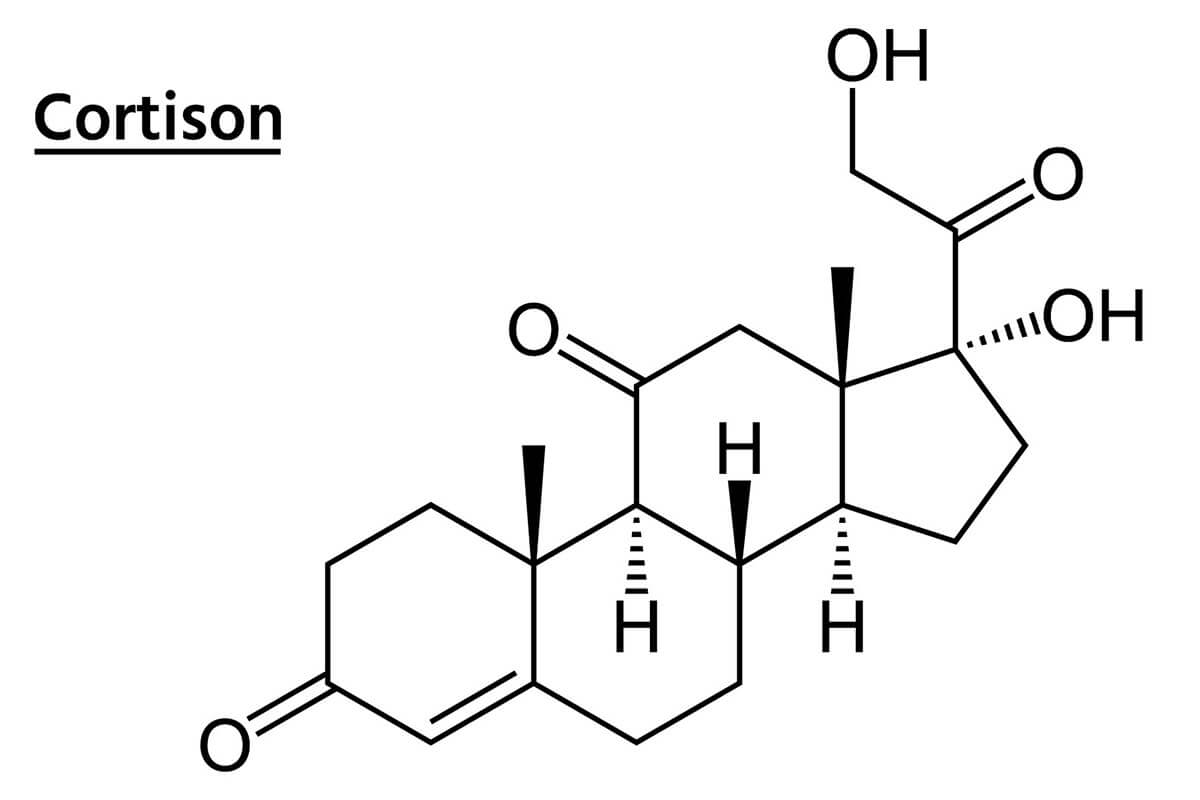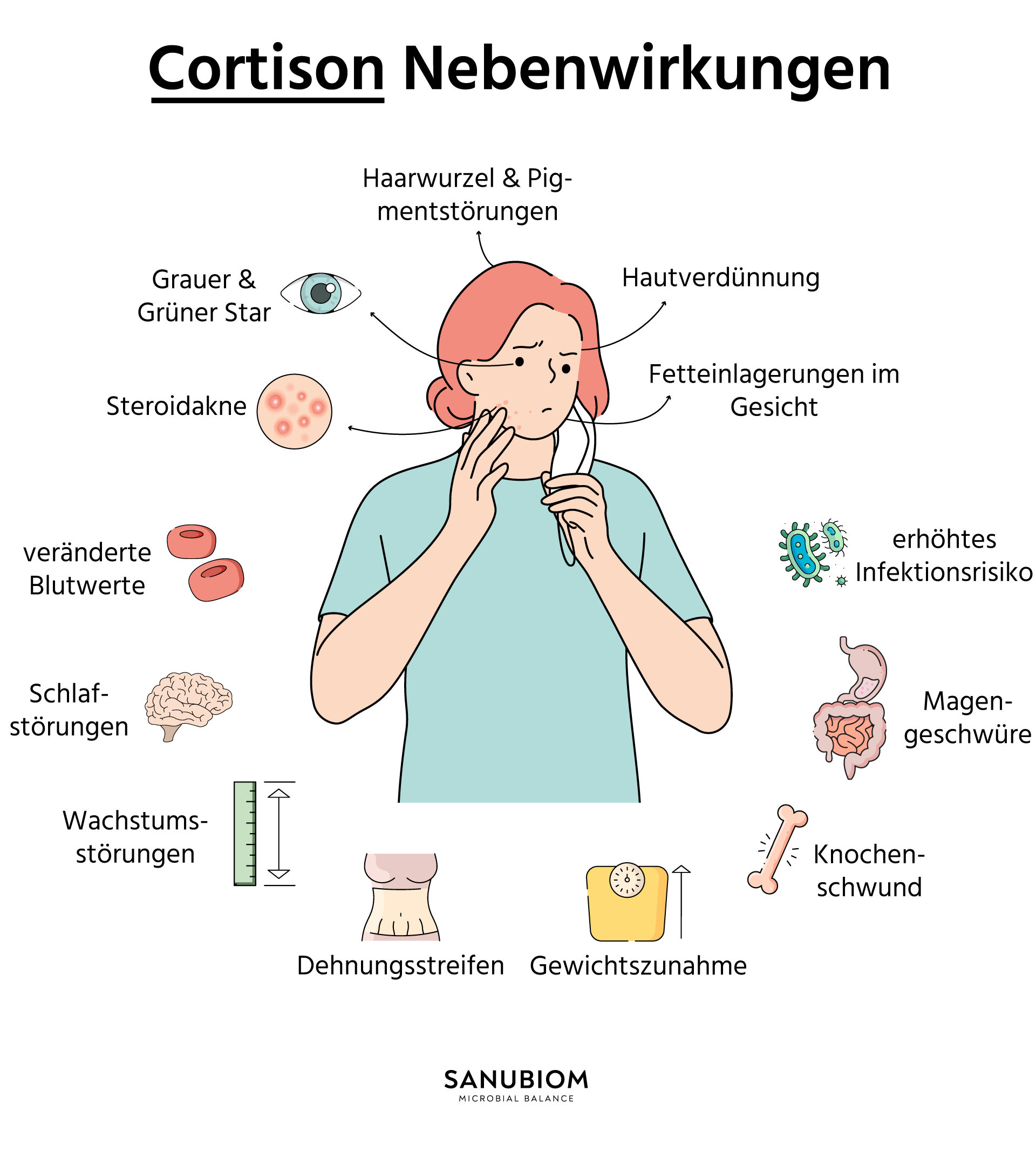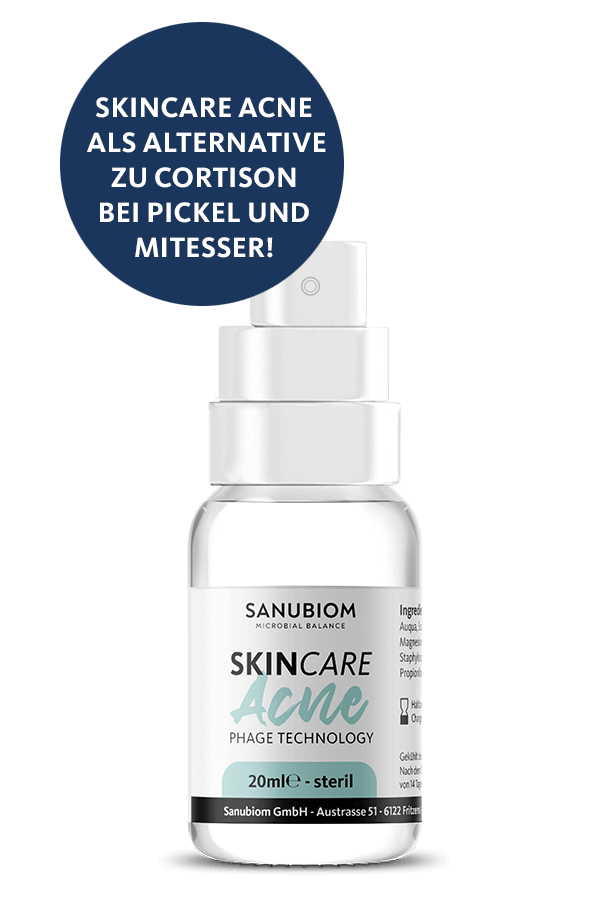Cortisone, also known as cortisone, is the inactive precursor of the glucocorticoid cortisol. Cortisone became known as a drug in the middle of the 20th century when it helped to temporarily relieve pain in a rheumatism patient.
Since then it has been used for many diseases, especially chronic or inflammatory (skin) diseases. However, the active ingredient causes many side effects. The side effects of cortisone are explained below.


Cortisone can be produced by the body itself, but can also be manufactured synthetically. It is a form of the glucocorticoid cortisol that is inactivated by oxidation.
Cortisol is a stress hormone that is produced in the adrenal cortex and is important for carbohydrate balance, fat metabolism and protein turnover. The liver can convert cortisone to active cortisol.
Cortisone was discovered in the 1930s and successfully used in humans for the first time in 1948: A rheumatism patient was temporarily pain-free after cortisone therapy.
The Nobel Prize for Medicine was awarded in 1950 for the discovery of cortisone.
Nowadays, corticosteroids or the synthetically produced cortisone acetate are used in therapy instead of cortisone. Glucocorticoids such as prednisolone, hydrocortisone or dexamethasone are also administered.
It should be noted that an overdose or too long an indication can lead to serious side effects.
The stress hormone cortisol fulfills several tasks in the body: it is essential in the catabolic metabolism, as it provides the body with energy, but also influences perception, thinking ability, cell division and cell development as well as inflammatory processes and the immune defense.
Accordingly, the effect of cortisol is divided into two areas:
Cortisol has an effect on the composition of minerals (especially potassium and sodium) in the blood and therefore also on blood pressure. This effect is usually undesirable.
In most cells of the human body, cortisone serves to provide energy and inhibit inflammation. The anti-inflammatory glucocorticoid effect plays a particularly important role in the treatment of rheumatoid arthritis.
This is achieved by two mechanisms:
Due to these two mechanisms of action, cortisol acts in various areas of the body: glucose metabolism, bones and muscles, brain and blood vessels, immune response and inflammation.
Since cortisone has been produced synthetically, there have been various preparations that differ in their duration and strength of action. In most cases, the mineralocorticoid effect should be suppressed and the glucocorticoid effect should be stronger.
The preparations differ in the way they are administered and their effect on the body.
It should not be forgotten that even locally administered cortisone has a somewhat systemic effect, as part of the dose is absorbed into the blood system.
The side effects of cortisone are varied and diverse due to the different effectiveness, potency and duration of action of the preparations. Systemically administered drugs have the most side effects.
As local indications can also cause side effects, the dosage should be kept as low and as short as possible, as with other medications.


The term “cortisone” is often used to refer to all glucocorticoids. However, there are over 30 different active ingredients in different strengths:
Accordingly, there are different forms of cortisone administration.
Local application via the skin
Ointments containing cortisone are applied directly to the affected areas of skin and can alleviate rashes. They are also used in the treatment of inflammatory skin diseases such as neurodermatitis, eczema or psoriasis.
Ointments have no effect on skin diseases such as acne, rosacea or skin fungus: they can even worsen the skin changes.
Cortisone injections
Cortisone is injected into the painful area of the body to relieve pain. These are injected in particular for carpal tunnel syndrome, bursitis, inflammatory joint diseases such as rheumatoid arthritis or pain in muscles.
Cortisone sprays
Sprays containing cortisone are either inhaled or sprayed into the nose. They are used for respiratory diseases such as asthma or chronic obstructive pulmonary disease as well as allergic rhinitis or chronic sinusitis.
Cortisone tablets
Cortisone tablets are primarily administered for chronic inflammatory diseases. These include multiple sclerosis, rheumatoid arthritis, intestinal diseases such as Crohn’s disease and ulcerative colitis as well as allergic reactions.
The side effects of cortisone-containing drugs vary depending on the form of administration and can range from relatively harmless to severe.


Like any other medication, cortisone also has side effects. The longer the therapy and the higher the dosage, the more varied and stronger they are. The following therefore applies: only take or apply cortisone for as short a time and in as low a dose as possible.
Ideally, a plan should be drawn up at the start of therapy as to when and how the medication is to be discontinued so that the extent of adverse effects remains low and the risk of addiction is minimized.
When cortisone is applied externally, as is the case with ointments, hair root and pigmentation disorders of the skin can occur or stretch marks can develop. If used incorrectly, the skin can also become thinner.
If cortisone ointments are applied to acne, rosacea or fungal skin infections, the condition may even worsen.

SKINCARE ACNE
Probiotic skin protection SkinCare Acne with Phage Technology.
Your skin comes to rest.
Cortisone tablets have the strongest side effects of all cortisone-containing drugs, as they act systemically (= throughout the entire body). The following side effects are possible if the duration of administration is too long and the dosage is too high:
The intake of cortisone tablets should always be discussed with the doctor treating you and should not be taken indiscriminately.
Secondary diseases/complaints can be detected at an early stage through check-ups that include blood pressure, bone density or blood values.
Long-term use over several months is generally not recommended due to the sometimes serious side effects.
Cortisone can change the hormone balance. Taking the glucocorticoid can reduce the body’s own hormone production and even lead to adrenal atrophy.
Abrupt discontinuation of therapy in particular increases the risk of hormonal side effects. It takes some time for the adrenal cortex to produce sufficient hormones (especially cortisol) on its own again.
If the medication is discontinued too quickly, a so-called rebound effect can also occur, which means that the original symptoms of the disease become more pronounced.

Although cortisone can be used to treat a wide range of diseases, it is not effective for all diseases. For example, skin diseases such as acne, rosacea or fungal skin infections can even be worsened by cortisone.
In addition, cortisone can have serious health side effects on the body, which is why cortisone therapies should be a rarity.
It is better to resort to alternative treatment options and only use cortisone in exceptional cases when there is no alternative.
For example, skin diseases such as acne, rosacea, neurodermatitis or skin fungi can be treated with bacteriophages is recommended.
Sprays with bacteriophages reduce bad bacteria on the skin, restoring the skin flora’s balance. The body tolerates natural alternatives better and they do not cause any side effects.